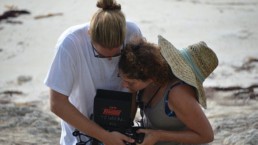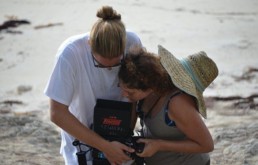Director Logan Sandler and DP Daniella Nowitz on Colorless Paradise in ‘Live Cargo’
"...Logan just said, 'What if we just shot this movie in black and white?' As a cinematographer, my first reaction was like, 'That's crazy! Look at where we're at, look at these colors!'" -Daniella Nowitz
We’ve been quoted as saying “Live Cargo” is “An unforgettable filmmaking debut,” and after talking to director Logan Sandler and cinematographer Daniella Nowitz, we even further emphasize that statement. In our exclusive interview, which took place the day before the film’s Los Angeles release (now playing at Arena Cinelounge Sunset), Sandler and Nowitz talk about the beginning of their creative relationship at AFI Film School, their disregard in following the traditional “classic” film structure, and the decision to shoot the picturesque island of Bimini in black and white.
The film has such a distinct visual style, and I’m always interested in the director/DP relationship. Have you two worked together before?
Logan Sandler: Yeah, we did our AFI thesis film together called “Tracks.” How AFI works is you collaborate with your crew for about a year prior to shooting, so Daniella and I already had a visual style and vocabulary already established prior to us making “Live Cargo.”
Daniella Nowitz: I remember being so impressed by Logan at AFI because I worked on one of his sets in my first year and we had this entire conversation about [Michelangelo] Antonioni. None of the other directors really cared who Antonioni was, and the school is so focused on American cinema, so it was really exciting to meet someone who also liked European cinema.
What was the leap like going from a short film to a feature film?
LS: There are so many other things at play when making a feature. Having Daniella onboard made that initial process of bringing the script to visual light was familiar.
DN: In the short, we got to experiment visually, and a lot of those things we took to the next level in the feature. Mostly, the long handheld moves that track with the character and not cutting away a lot. We also got to shoot with the same actor, Lakeith Stanfield, which was really helpful because I already knew how he would photograph and move.
“We ended up turning efficiency into a creative strength.” -Logan Sandler

It sounds like you had a great director/DP/actor dynamic. How did the three of you work together?
LS: My process with Lakeith is very organic and intuitive. We’ve established a sense of trust between actor, director, and camera. He was very in tune to understanding how we worked and what we wanted from him.
DN: Knowing that Logan wanted these long, flowing handheld shots, I was able to bring on my camera operator, Julián Estrada, who also worked on the short. I am 5 feet tall… haha. I can operate handheld but when you have to do long tracking shots of people who are taller, I need to work with an operator. Julián is amazing, he also collaborated with us and was ready to do the craziest, longest shots.
Was the script ready when you signed on?
DN: There was a script, and I told Logan it was one of the most beautiful things I have ever read and I have to shoot this movie. I think we had first imagined “Live Cargo” as a more “classic” film with “classic” structure, but when we got to the Bahamas, the place took over the story. In the best possible way! It really dictated so many of our decisions, including the black and white look and non-traditional narrative structure. That structure is one of my favorite things about the movie because I think it really reflects the experience of being on this island, the way life flows over you- like the waves of the ocean.
LS: Yeah, it wasn’t necessarily possible to bring a dolly or other instruments we use to achieve certain cinematic moments. In order to achieve the authenticity of the location, we chose to use a handheld camera for a lot of the shoot because it opened us up to capturing the characters in their true self. It allowed them to roam freely without weighing them down.
DN: On a lighting level, we kept it very simplistic. We wanted the authenticity of the place, we didn’t want to light this like a Hollywood movie. Whenever we could shoot without lights, like in a bar or in a club, we would shoot without lights. And it’s not like we had a truck with a lift gate, we were on this island that has one main road that’s very narrow at parts and not paved. There was no way we could ride around with [a ton of gear].
LS: We ended up turning efficiency into a creative strength.
I loved the decision to shoot in black and white, that’s what made “Live Cargo” leave a lasting imprint in my mind.
LS: To be frank, one of the reasons why we chose to shoot in black and white, outside of our thematic, metaphorical, and other artistic reasons, was because after looking at our test stills with our collaborators, many times people would walk away from the images and the first thing they would remember was how blue the water was. That’s not something we wanted to portray in the film. So there was confidence in the freshness and originality of approaching it in black and white.
DN: I still remember the moment Logan brought up the black and white idea. We had gone down to the Bahamas to location scout and shoot some test footage, and after watching the footage back, something felt off. I remember we were having a beer at the end of the day and Logan just said, “What if we just shot this movie in black and white?” As a cinematographer, my first reaction was like, “That’s crazy! Look at where we’re at, look at these colors!” After I thought about it for a minute, I knew that was it.
“…Logan just said, “What if we just shot this movie in black and white?” As a cinematographer, my first reaction was like, “That’s crazy! Look at where we’re at, look at these colors!'” -Daniella Nowitz

Is there anything you want audiences to know about the culture in the Bahamas?
DN: I’ve shot in almost 30 countries and I’m very used to going into a culture and absorbing it. What was different for me [in the Bahamas] was the feeling of the place, the feeling of island life. Everybody knows each other. The day we left the island, people were crying because they were so sad to see us go. We became a part of the fabric of this island. For me, the real experience here is going to a tiny place and becoming a part of it.
LS: Yeah, everybody in the crew put away their laptops… no one was on Facebook or Twitter or Instagram because the atmosphere there opens up to a lot more self-reflection. Myself, the actors, the crew- there was a lot more self-reflection during the shoot even though we were busy as shit. I think everyone grew, and became a better person in a way, once we left the island because of that.
After wrapping up the shoot for a day, how would you prepare for the next day?
LS: Oh it was crazy, insane. I’m not gonna lie, it was like out of one of Werner Herzog’s crazier documentaries. There were a lot of issues with closing down locations and confirming locations for the next day. There were countless times when Daniella and I had scouted and confirmed a location, and about 50% of the time, once we got there [to shoot], the owners of the location wouldn’t answer! So as far as planning for the next day of shooting, we always had to have a backup plan, and a lot of times, multiple backup plans.
DN: And because of that, we had to be ready to shoot any part of the movie at any given moment. It wasn’t like a regular shoot where you know what scenes you’re shooting in week one. We tried to do that as much as possible but we had to be flexible with the island. But for as hard as it was in the moment, in retrospect, some of the most beautiful moments in the film came out of those scenarios. Like the scene where Dree Hemingway is dancing in the club; we had a different location planned but we just came across that place and it was perfect. We literally just asked if we could come in and shoot and we shot the scene in about an hour.
“So there was confidence in the freshness and originality of approaching it in black and white.” -Logan Sandler

Has anyone from the island been able to see the film?
LS: The local audience that has seen the film has received it very well. We screened at the Bahama Film Festival and won the top award there. What really blew me away was the night of our Tribeca premiere: Two of our locations were provided by the same family and they had been tracking the film since we left. On their own, they bought tickets to New York City, got a hotel, and were waiting at the film’s premiere at the Tribeca Film Festival. They bought tickets and everything, they wanted to see it! It was definitely a film made by a community, I can say that.
Do you have any advice, specific to your roles as director and DP, for those working in independent film?
DN: The most important thing, in the same vein of what we’ve been talking about, is being flexible. Also, understand the importance of the collaboration process you’re a part of. And having a good time! As hard as the shoot was, what made the actors and crew enjoy themselves and the locals happy to have us is that we all did this shoot with so much love. It sounds like a cliche but it’s really true.
LS: That’s well said! I would echo those same sentiments. The only way to get an indie film done is with your team. There will be a lot of trials and tribulations along the way and it’s not going to be easy, but if you’re determined enough to make it happen and believe in your heart that what you’re doing is really what you should be doing, then the sky’s the limit.
H. Nelson Tracey
Nelson is a film director and editor from Denver based in Los Angeles. In addition to writing for Cinemacy, he has worked on multiple high profile documentaries and curates the YouTube channel "Hint of Film." You can check out more of his work at his website, hnelsontracey.com


